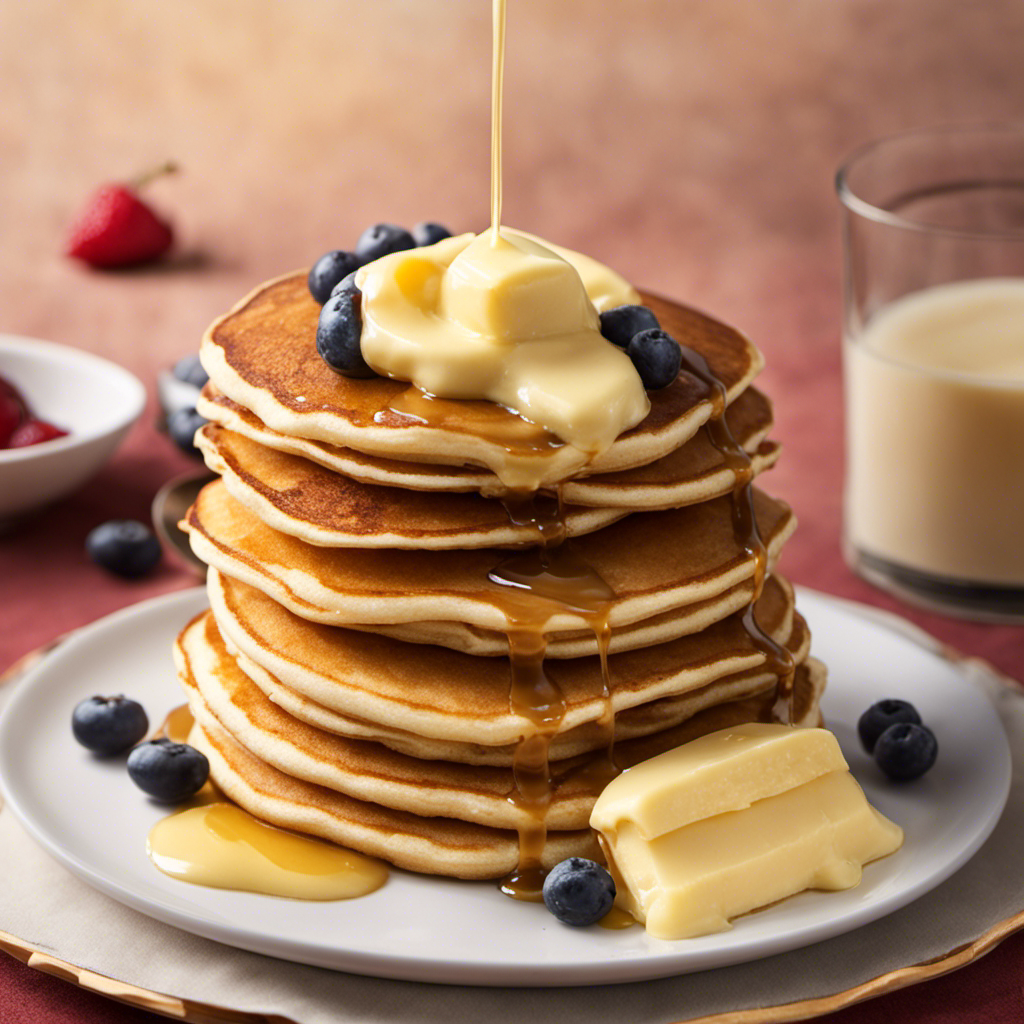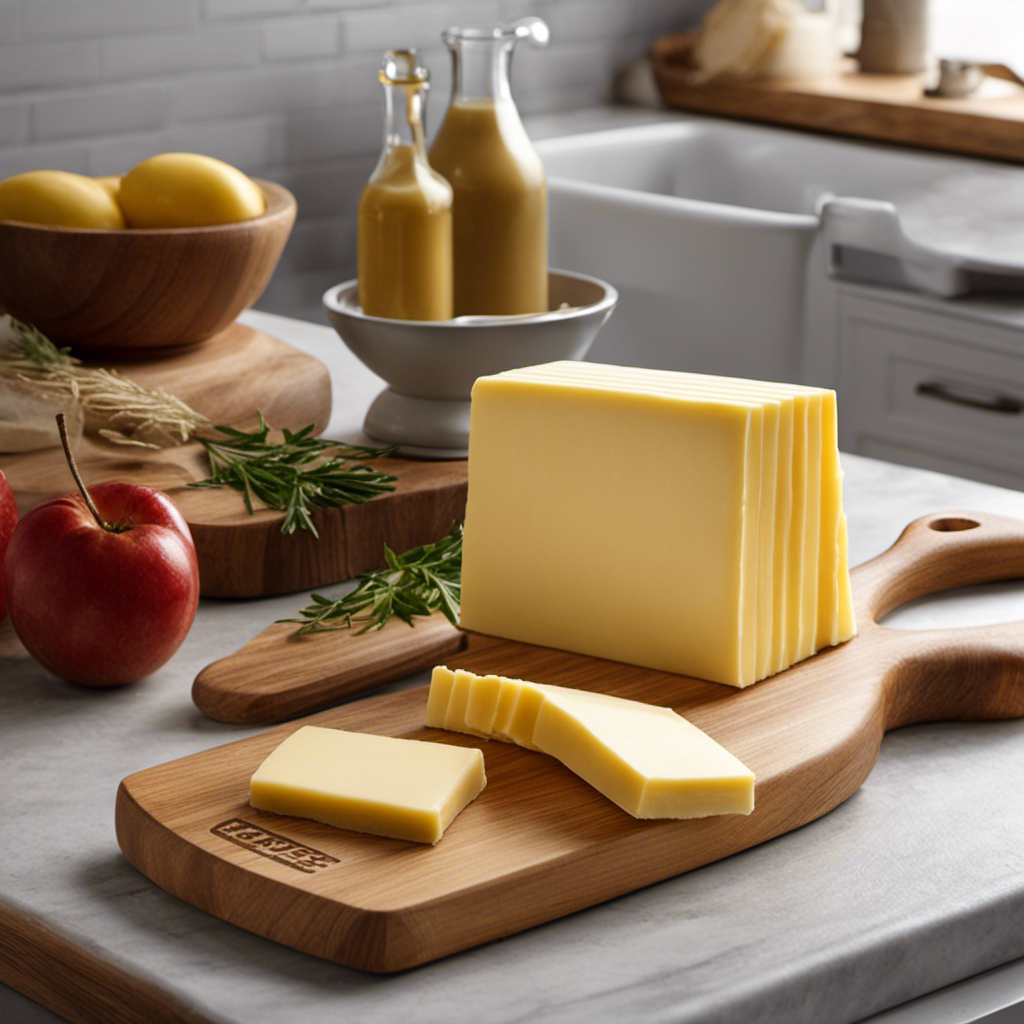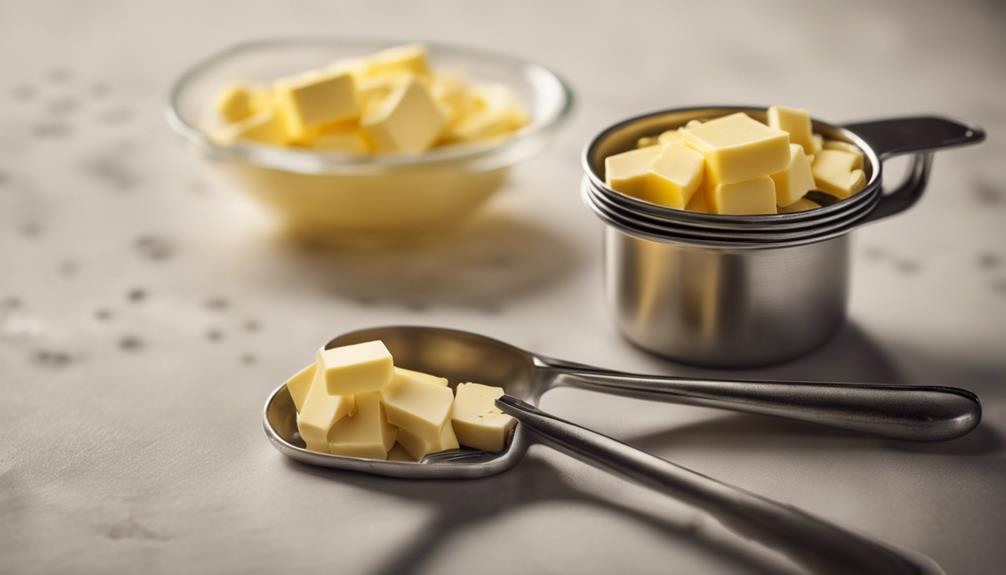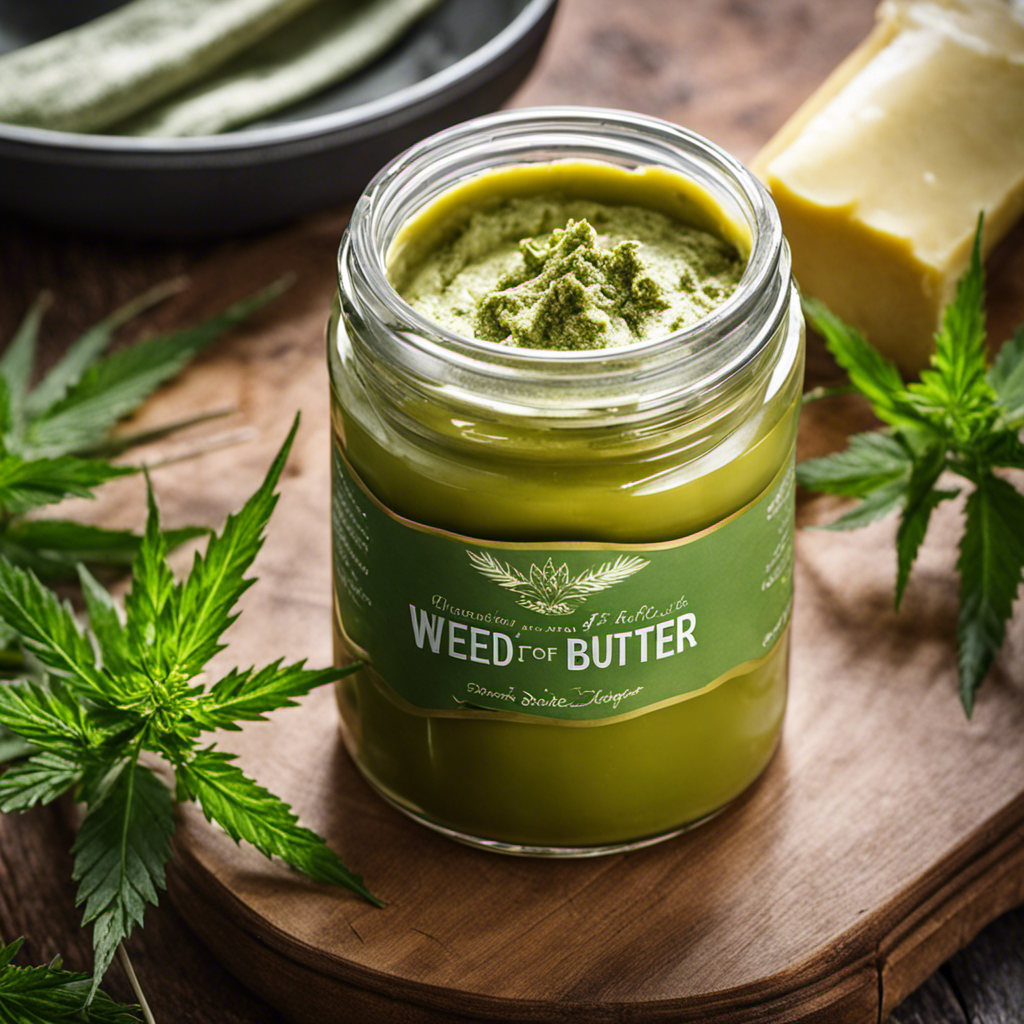I’ve always been curious about the calorie count in a basic tablespoon of butter. It’s among the common ingredients that significantly impact the nutritional value of our dishes.
In this article, we’ll explore the caloric value of butter and its implications for our health. We’ll also learn how to measure a tablespoon of butter accurately and discuss ways to moderate our intake.
So, let’s dive in and uncover the facts behind this creamy indulgence.
Key Takeaways
- Butter typically contains around 100 calories per tablespoon.
- Butter is high in calories, with approximately 102 calories per tablespoon.
- Butter is high in saturated fat and cholesterol, increasing the risk of heart disease and weight gain.
- Using alternative spreads or reducing butter in recipes can help manage weight and mitigate the risks associated with butter consumption.
Butter and Calorie Count
Butter typically contains around 100 calories per tablespoon. However, if you’re looking to cut back on calories, there are some alternatives you can consider.
One option is to use butter substitutes, such as margarine or vegetable spreads. These options often have fewer calories and can still provide a similar taste and texture to butter.
Another way to reduce calorie intake is by adjusting your cooking methods. For example, instead of slathering butter on your toast, you can try using a thin layer or opting for a healthier spread like avocado or nut butter. In cooking, you can also use cooking sprays or non-stick pans to minimize the need for excessive butter.
Understanding Serving Sizes
Understanding serving sizes can be tricky, especially when it comes to measuring out the right amount of ingredients. When it comes to measuring butter, it’s important to know the correct serving size to ensure accurate nutrition information.
Here are some tips to help you with measuring butter:
- Use a kitchen scale: Weighing your butter is the most accurate way to measure it.
- Look at the packaging: Butter sticks usually have markings to indicate tablespoon measurements.
- Use measuring spoons: If you don’t have a kitchen scale, measuring spoons can be a good alternative.
- Pay attention to the recipe: Some recipes may specify the butter measurement in different forms (e.g., melted, softened).
Understanding serving sizes is crucial for accurately tracking your nutritional intake.
Now let’s break down the nutritional facts of butter.
Breaking Down the Nutritional Facts
When it comes to understanding the calorie content and nutritional value of butter, there are a few key points to consider.
First, it’s important to note that butter is high in calories, with approximately 102 calories per tablespoon.
Second, while butter does contain small amounts of certain nutrients like vitamins A and D, it is also high in saturated fat, which can contribute to heart disease.
Lastly, when assessing the nutritional value of butter, it’s crucial to keep portion sizes in mind and consider healthier alternatives for cooking and spreading.
Butter’s Calorie Content
To find out the calorie content of a tablespoon of butter, you can check the nutrition label on the packaging.
Butter is a staple ingredient in baking and cooking, adding richness and flavor to dishes. However, it is important to be mindful of the calorie content when using butter in your recipes.
Here are a few key points to consider:
- Butter is high in calories, with approximately 102 calories per tablespoon.
- When baking, consider using alternatives such as applesauce or Greek yogurt to reduce the calorie content.
- In cooking, you can use smaller amounts of butter and supplement with healthier oils like olive oil or avocado oil.
- Remember to practice portion control and be mindful of the overall calorie intake in your meals.
Nutritional Value Assessment
Applesauce and Greek yogurt can be used as healthier alternatives to reduce the calorie content when baking with butter. While butter adds richness and flavor to baked goods, it is high in saturated fat and calories. By substituting some or all of the butter with applesauce or Greek yogurt, you can significantly reduce the calorie content without sacrificing taste or texture.
Applesauce is a great option because it adds moisture to the recipe, allowing you to use less butter. It also adds natural sweetness, which can reduce the need for additional sugar. Greek yogurt, on the other hand, provides a creamy texture and tangy flavor. It is also high in protein, making it a nutritious choice.
When using these alternatives, it is important to note that they may affect the final outcome of your baked goods. Adjustments to the recipe, such as adding a little extra flour or baking powder, may be necessary. It may also be helpful to experiment with different ratios of butter alternatives to achieve the desired taste and texture.
How to Measure a Tablespoon of Butter
Measuring a tablespoon of butter is simple if you use a measuring spoon. It ensures accuracy and consistency in your recipes.
To measure butter accurately, follow these steps:
- Start by taking a stick of butter and removing the wrapper.
- Use a sharp knife to slice the butter evenly into tablespoon-sized portions.
- Level off the top of each tablespoon using the back of a knife.
- Transfer the measured butter into a bowl or directly into your recipe.
Converting tablespoons of butter to grams can be helpful when following recipes that use metric measurements. One tablespoon of butter is equivalent to approximately 14 grams. This conversion can be useful if you need to adjust the amount of butter in a recipe or if you prefer to measure ingredients using a kitchen scale.
The Caloric Value of Butter
If you’re watching your calorie intake, it’s important to be aware of the caloric value of butter. A tablespoon of butter contains approximately 102 calories. This means that if you use butter in your cooking or baking, those calories can quickly add up.
However, there are alternatives to butter that can help reduce your calorie intake. For instance, you can use olive oil or coconut oil as substitutes in some recipes. These alternatives have lower caloric values compared to butter, making them a healthier choice.
When it comes to baking, you can also try using applesauce or mashed bananas to replace butter. These options not only reduce the calorie content but also add moisture and flavor to your baked goods.
Transitioning into the next section, let’s now compare the caloric value of butter to other fats.
Comparing Butter to Other Fats
When comparing butter to other fats, it’s important to consider their caloric values and how they can impact your overall calorie intake. Butter is a popular choice for cooking and baking, but there are alternatives that can provide similar taste and texture.
Here are some key points to consider when comparing butter to other fats:
-
Butter alternatives like olive oil and avocado oil are lower in saturated fat and calories. These alternatives also contain beneficial nutrients like monounsaturated fats and antioxidants.
-
When it comes to nutrient composition, butter is a good source of vitamin A and saturated fat. However, it is high in calories and may contribute to weight gain if consumed in excess.
Considering the caloric value and nutrient composition of butter alternatives can help you make informed choices about your fat intake and overall health.
Butter and Weight Management
When it comes to managing weight, it’s important to consider the calorie content of butter. A tablespoon of butter contains about 100 calories, which can quickly add up if used generously.
Excessive consumption of butter can contribute to weight gain, so it might be worth exploring alternative options or using it in moderation as part of a balanced diet.
Butter and Calorie Content
The calorie content of a tablespoon of butter is approximately 100 calories. When it comes to weight loss, butter can be a tricky ingredient. However, there are alternatives available for baking that can help with your weight management goals.
Here are some butter alternatives to consider:
- Coconut oil: With its natural sweetness and high smoke point, coconut oil can be a great substitute for butter in baking.
- Applesauce: This fruit puree adds moisture to your baked goods and can replace butter in recipes.
- Greek yogurt: Using Greek yogurt instead of butter brings a creamy texture and added protein to your baked treats.
- Avocado: Mashed avocado can replace butter in recipes, providing healthy fats and a rich, creamy texture.
By incorporating these alternatives, you can enjoy your favorite baked goods while staying mindful of your calorie intake. However, it’s important to remember that weight loss is a complex process that involves overall dietary habits and physical activity.
Transitioning to the next section, let’s explore the relationship between butter and weight gain.
Butter and Weight Gain
If you’re concerned about weight gain, it’s important to be mindful of your butter consumption. Butter is delicious and adds flavor to many dishes, but it is also high in calories and fat.
To achieve weight loss goals, portion control is key when it comes to butter. A tablespoon of butter contains around 100 calories and 11 grams of fat. This may not seem like much, but those calories can add up quickly, especially if you use butter generously in cooking or on toast.
To manage your weight, consider using alternative spreads or reducing the amount of butter you use in recipes. Portion control is a simple and effective way to enjoy the taste of butter while still reaching your weight loss goals.
Butter Substitutes for Weight
To manage your weight, you can try using alternative spreads as a substitute for butter. Butter alternatives provide a healthier option that can help you maintain a balanced diet. Here are some healthy butter options to consider:
- Avocado spread: Made from ripe avocados, this spread is packed with healthy fats and nutrients like vitamin E and potassium.
- Greek yogurt spread: Greek yogurt is a rich source of protein and calcium, and can be used as a creamy substitute for butter in baking and cooking.
- Nut butter: Almond butter, peanut butter, and other nut butters are delicious spreads that offer a good amount of protein and healthy fats.
- Olive oil: Although not a spread, olive oil can be used as a healthier alternative to butter in cooking and baking, providing a dose of heart-healthy monounsaturated fats.
Health Implications of Consuming Butter
Consuming butter regularly can have negative health implications. While butter can be tasty and add flavor to dishes, it is high in saturated fats and cholesterol, which can increase the risk of heart disease and contribute to weight gain.
However, there are several alternatives to butter that offer health benefits. One option is to use olive oil, which is rich in monounsaturated fats that can help lower bad cholesterol levels.
Another alternative is avocado, which provides healthy fats, fiber, and antioxidants. Nut butters, such as almond or peanut butter, are also great alternatives as they are high in healthy fats and protein.
Butter and Cholesterol Levels
When it comes to butter and heart health, there are a few key points to consider.
First, butter is high in saturated fat, which has been linked to increased levels of LDL cholesterol, also known as ‘bad’ cholesterol.
Secondly, consuming high amounts of saturated fat from butter and other sources can increase the risk of heart disease.
Therefore, it is important to be mindful of our butter consumption and opt for healthier alternatives when possible.
Butter and Heart Health
Butter can impact heart health when consumed in excessive amounts due to its high saturated fat content. Saturated fat has been linked to an increased risk of heart disease and can raise LDL cholesterol levels, which is often referred to as ‘bad’ cholesterol.
Additionally, research has shown that consuming too much saturated fat can increase inflammation in the body, which can further contribute to heart disease.
It is important to note that while butter can have negative effects on heart health, it can also be enjoyed in moderation as part of a balanced diet.
To reduce the impact of butter on heart health, consider using healthier alternatives such as olive oil or avocado spread, which are lower in saturated fat and contain heart-healthy monounsaturated fats.
Dietary Implications of Butter
To maintain a healthy diet, it’s important to be mindful of the amount of butter you use in your cooking and baking. While butter can add flavor and richness to dishes, it is also high in calories and saturated fat, which can contribute to weight gain and increased risk of heart disease.
One tablespoon of butter contains approximately 100 calories and 11 grams of fat. However, it’s important to note that butter does offer some nutritional benefits. It is a good source of vitamin A and E, which are important for eye health and immunity. Additionally, butter contains small amounts of other vitamins and minerals like calcium and phosphorus.
To balance the nutritional benefits with the potential drawbacks, it’s recommended to use butter in moderation and opt for healthier cooking oils or substitutes when possible.
Butter in Different Recipes
You’ll find that butter is used in a variety of recipes, each adding its own unique flavor and richness to the dish. Whether you’re baking a batch of chocolate chip cookies or sautéing vegetables, butter plays a crucial role in enhancing the taste and texture of your favorite dishes.
However, if you’re looking for alternatives to butter or trying to reduce your butter intake, there are a few options to consider:
-
Coconut oil: This plant-based alternative can be used in baking and cooking, and it adds a subtle, nutty flavor to your recipes.
-
Greek yogurt: In some recipes, you can replace butter with Greek yogurt to reduce the fat content while still maintaining moisture.
-
Avocado: Mashed avocado can be used as a butter substitute in certain recipes, adding a creamy texture and healthy fats.
-
Applesauce: For baked goods, using applesauce instead of butter can reduce the calorie and fat content while adding natural sweetness.
By exploring these butter alternatives, you can enjoy your favorite recipes with a healthier twist.
Now, let’s dive into some tips for moderating butter intake and making mindful choices in your diet.
Tips for Moderating Butter Intake
If you want to cut back on your butter consumption, there are a few strategies you can try.
First, consider using butter in moderation rather than completely eliminating it from your diet. Butter can add flavor and richness to dishes, so it’s okay to enjoy it in small amounts.
Secondly, opt for healthier butter options. Look for grass-fed butter, which contains higher levels of omega-3 fatty acids and vitamin K2. You can also try using spreads made from avocado or nut butters as alternatives to traditional butter.
Lastly, be mindful of portion sizes. Stick to the recommended serving size of one tablespoon, and consider using less butter in your recipes by substituting with healthier alternatives like olive oil or applesauce.
Frequently Asked Questions
Can Butter Be Substituted With Other Fats in Recipes?
Butter can be substituted with other fats in recipes. Using alternative fats like olive oil or coconut oil can provide health benefits such as lower saturated fat content. Some of the best butter substitutes include avocado, Greek yogurt, and applesauce.
What Are the Health Benefits of Consuming Butter?
Consuming butter in moderation can provide health benefits, such as a good source of vitamins A and E. However, it is important to be mindful of its high saturated fat content and consider butter alternatives to reduce health risks.
How Does the Caloric Value of Butter Compare to Other Common Spreads?
Compared to other common spreads, butter has a higher caloric value. However, it’s important to consider the overall nutritional comparison. While high in calories, butter also provides essential nutrients like vitamin A and fatty acids.
Can Consuming Butter in Moderation Contribute to Weight Management?
Moderate butter consumption can contribute to weight management by providing satiety and flavor. However, it’s important to consider the high caloric density of butter and its potential effects on heart health and blood sugar levels.
Are There Any Specific Health Implications of Consuming Butter for Individuals With High Cholesterol Levels?
When it comes to high cholesterol levels, specific dietary recommendations are crucial. Butter, while tasty, can have a negative impact on heart health due to its high saturated fat content. Moderation is key.
Conclusion
In conclusion, it’s clear that moderation is key when incorporating butter into our diets. A tablespoon of butter contains about 102 calories, so it’s important to be mindful of how much we use. While butter can enhance the richness and flavor of dishes, we must also consider its impact on our cholesterol levels. To maintain our health, it’s crucial to use butter in moderation and choose healthier alternatives whenever possible. By doing so, we can still enjoy the benefits of butter without compromising our well-being. So, remember, a little butter goes a long way!










